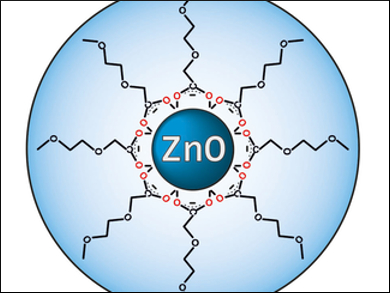Zinc oxide nanocrystals (ZnO NCs) are one of the most widely used nanomaterials. However, the toxicological impact of ZnO nanostructures still remains unclear. In contrast to the bulk material, which has been classified as “Generally Recognized as Safe” by the U.S. Food and Drug Administration (FDA), ZnO NCs have unique characteristics, but also the potential to generate various unwanted modes of toxicity.
To solve the safety issue, Janusz Lewiński, Warsaw University of Technology, Poland, and Polish Academy of Sciences, Warsaw, have developed a “safe-by-design” strategy for the preparation of biocompatible ZnO NCs. The nanocrystals are coated with a densely packed shell of 2-(2-methoxyethoxy)acetate (MEAA) ligands (pictured).
The resulting NCs have unique properties like ultra-long photoluminescence decay, high quantum yield, inertness in biological environments, and very low toxicity toward lung cells. Moreover, this organometallic method prevents both reactive oxygen species generation and leaching of Zn2+ ions from the inorganic core. The prepared ZnO NCs could have applications in bio-imaging, bio-targeting, and bio-sensing.
- Safe-by-Design Ligand-Coated ZnO Nanocrystals Engineered by an Organometallic Approach: Unique Physicochemical Properties and Low Toxicity toward Lung Cells,
Małgorzata Wolska-Pietkiewicz, Katarzyna Tokarska, Agnieszka Grala, Anna Wojewódzka, Elżbieta Chwojnowska, Justyna Grzonka, Piotr J. Cywiński, Krzysztof Kruczała, Zbigniew Sojka, Michał Chudy, Janusz Lewiński,
Chem. Eur. J. 2018.
https://doi.org/10.1002/chem.201704207




